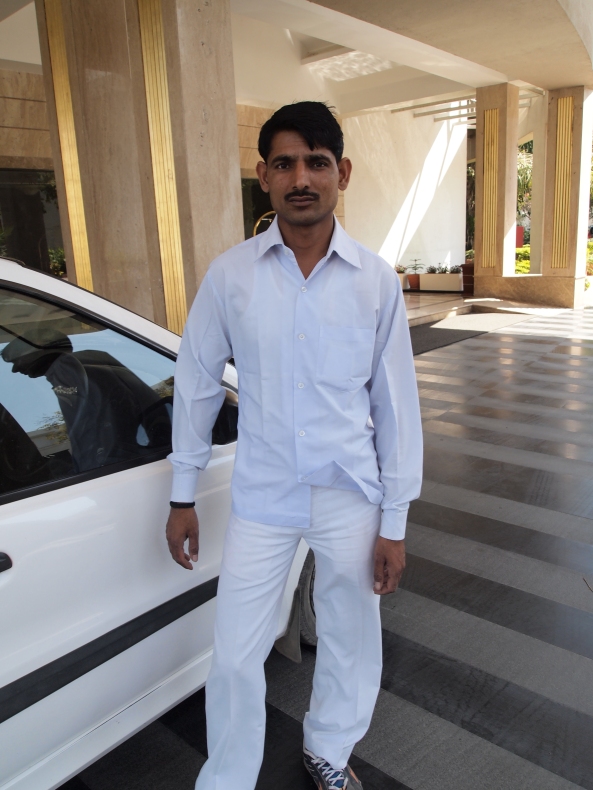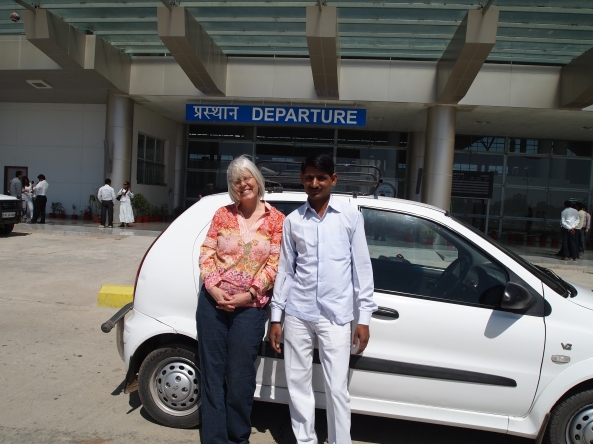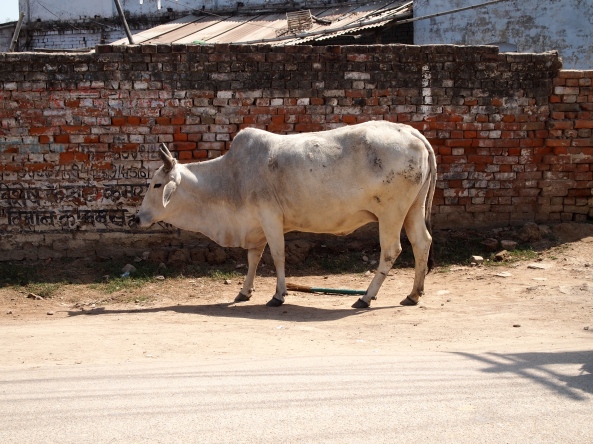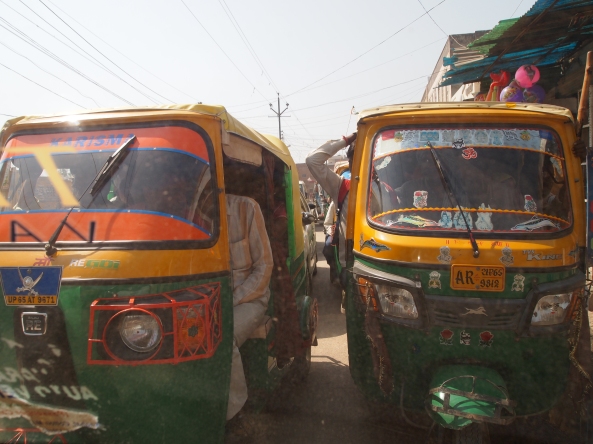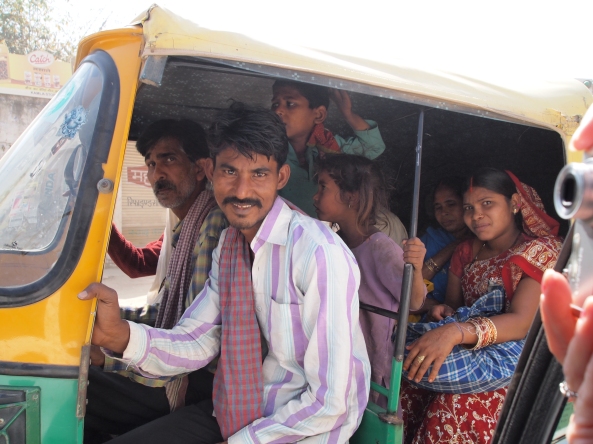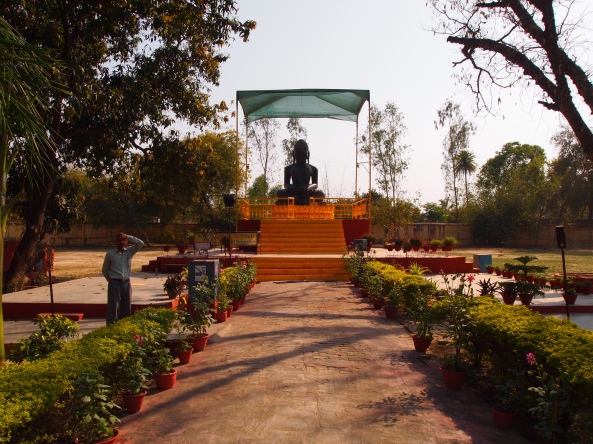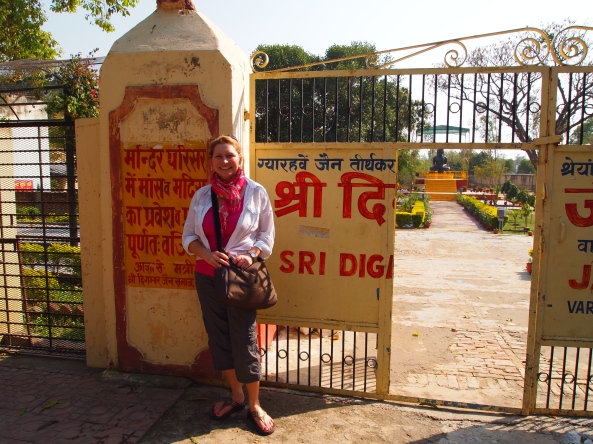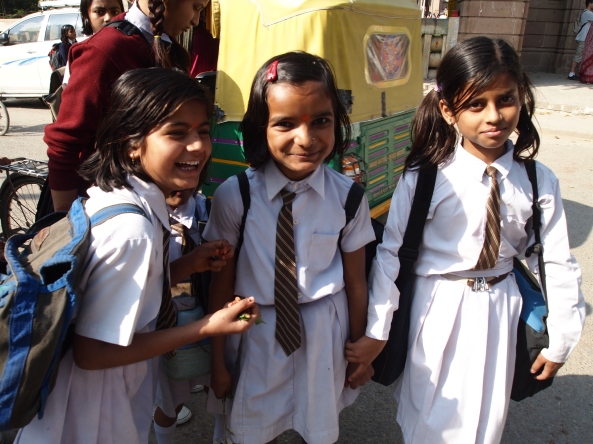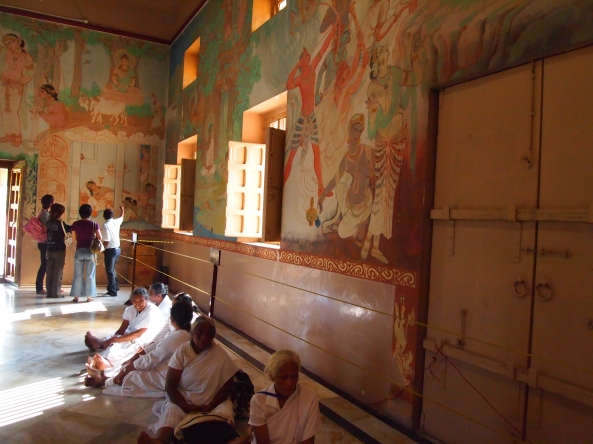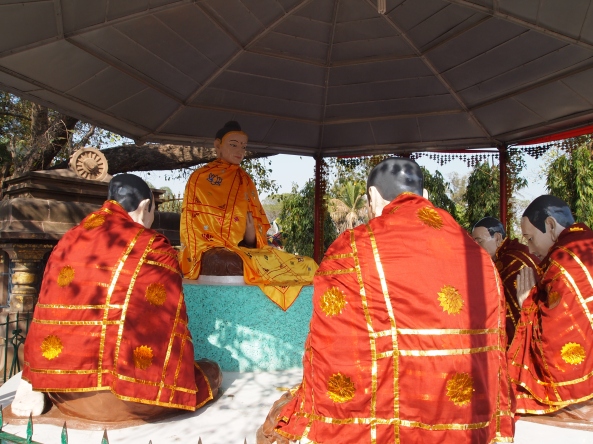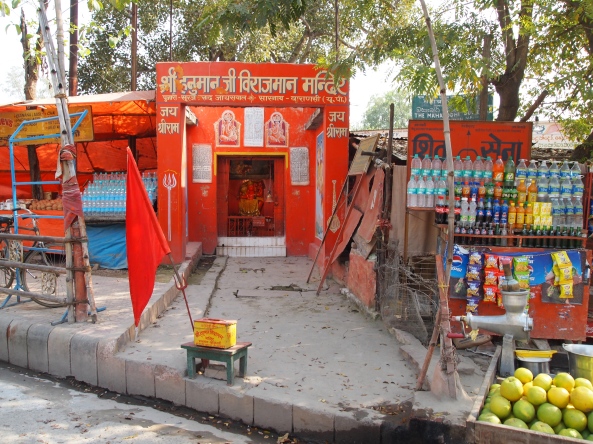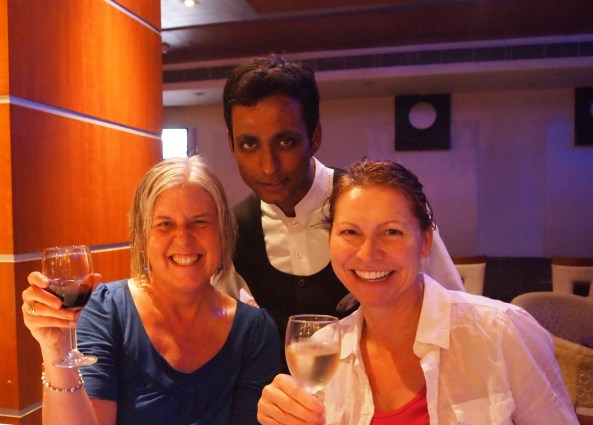Sunday, March 6: Sunrise on the Ganges. We head into Varanasi proper and, in the dark, make our way down the maze of alleys called galis to the ghats, the long expanse of steps leading into the water on the western bank of the Ganges. The word “ghat” means step, and the ghats in Varanasi are named after maharajahs. There are 80 ghats that border the river. Hindu pilgrims flock to the ghats to either wash away their sins in the sacred Ganges or to cremate their dead. Varanasi is considered a holy and favorable place to die and thus is the center of the Hindu universe; a person who dies here is believed to be liberated from the cycle of birth and death.

on the ghats heading to our sunrise boatride
Our boat guide is Ajay and for once, we’ve met an Indian that speaks near-perfect English. We can actually understand most of what he says. We slide into his rickety rowboat, and a young boy rows us out into the river. The ghats and the buildings on land glow like warm terra-cotta in the streetlights and the pre-dawn light, and people are out in droves bathing in the Ganges. It’s peaceful and gorgeous, with this orange glow, with the sound of oars slapping the surface of the river, the quiet boats full of orange-robed monks, photo-snapping Asian tourists, and other fellow nomads. On the ghats, pilgrims offer puja, meaning offerings or prayers, to the rising sun.

Ajay, our boat guide
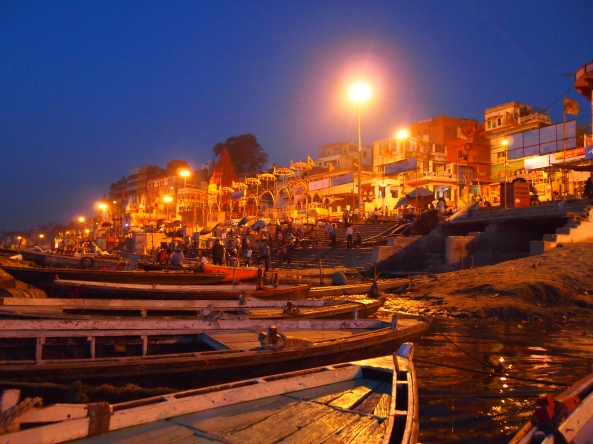
boat on the Ganges
We start at Dasaswamedh Ghat, the liveliest and most colorful ghat, with its flotilla of boats and its two pink towers painted with gaudy Hindu gods. Along the shore we watch people washing clothes in the Ganges, students doing yoga and meditation and studying Sanskrit, women selling flowers, and people just hanging out.

Dasaswamedh Ghat

the Ghats
Ajay tells us about the laundry businesses, people who get paid to actually wash clothes in the filthy Ganges. It’s a rather disgusting thought. It is said the river is filled with chemical wastes, sewage and even human and animal remains. These carry major health risks for those who bathe in or drink the dirty water. However, the river seems to self-purify, possibly due to its relatively high oxygen levels, thus preventing large-scale disease breakouts like cholera or dysentery.
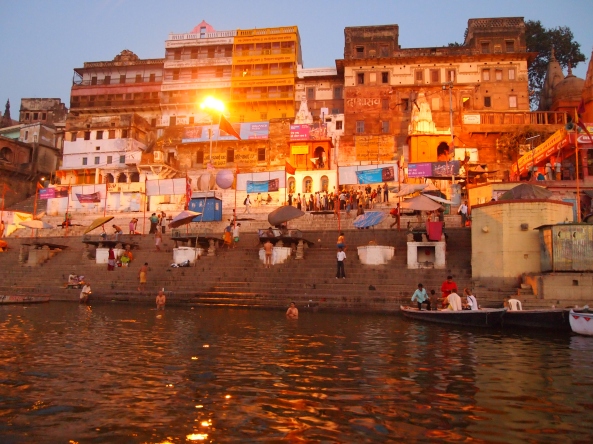
people bathing in the Ganges
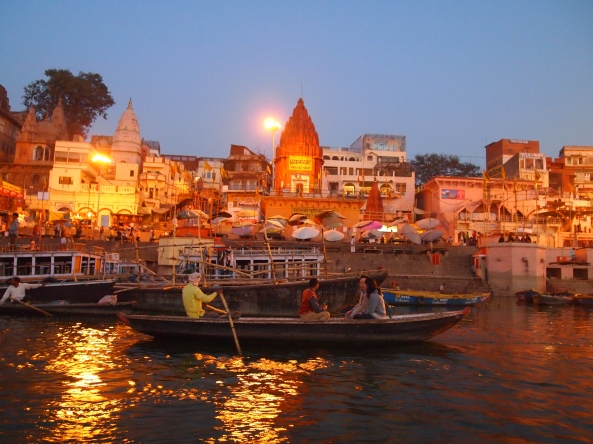
on the Ganges

the ghats

the ghats
People are cremated along the river, either by traditional burning on piles of sandalwood, which is most expensive, or mango wood. If people can’t afford sandalwood, they can buy packets of sandalwood dust to sprinkle on the fire. In recent years, there are is also electronic burning in oven-like crematoriums, which reduces the amount of wood used. Ajay tells us that every Hindu is cremated at death except for: (1) children under the age of 15; (2) pregnant women; (3) people with leprosy; (4) people who die from snake bites; and (5) priests. These deceased are thrown directly into the River Ganges.

Jayne on the Ganges
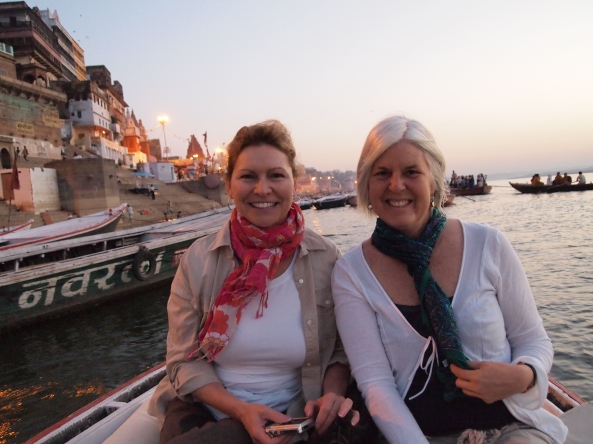
Jayne and me: sunrise boatride on the Ganges
We row silently along in the boat and it’s awe-inspiring to watch the sacred rituals in this holy place. This experience ranks up there with my balloon ride over Cappadocia in Turkey this past summer. Amazing. Ajay gives us little candles set on a flower petal bed, tells us to light the candle and place it into the river. I cup my hands around the candle to shield the flame from the breeze, light it and make a wish. Always, my wishes pertain to love, but I dare not reveal more. I don’t want to jinx my wish. We watch as our candle-wishes float away on the current, diminishing on the horizon to nothingness.

i light my candle and send it down the river with love wishes
On the way back to shore, Ajay casually tells us about a famous guru he knows who told the fortune of a famous actress named “Goal Lyan,” or some such name which we can’t understand for the life of us. We keep guessing different names, until finally Ajay calls his brother and puts us on the phone with him. He says the actress was Goldie Hawn! Then he tells us that there are a lot of gurus, but this one he knows is really good, so if we’d like to have our stars read and our futures told, he’s the one to see. We must look like a couple of suckers to Ajay, and in fact we turn out to be just such!

boats with orange-robed monks

the sun rises over the ghats

the holy Ganges in Varanasi

other folks on the river
Our boat pulls up after an hour to Manikarnika Ghat, the main burning ghat. Day and night, hundreds of pyres are tended by the Dom, the untouchable caste which has handled cremation for centuries. The pyres are lit with an eternal flame believed to have emanated from Lord Shiva, the patron deity of Varanasi. We see some smoking ashes and burning pieces of wood, but we don’t see any huge piles of firewood actually burning a dead body. All the bodies left here have already turned to ash and have been swept into the river. Everywhere is the stench of cows and general garbage and debris, but I can’t really smell burning flesh, which is good. I’ve always heard it’s a horrible smell; I don’t think I’ve ever smelled it before, but I think I’d know if I did. We pick our way through the black ash, huge piles of wood, wandering cows, more mangy dogs, goats, and a squatting old man shaving the eldest in the deceased’s family with a straight-edge to prepare him for the cremation. We must walk through this area quietly and respectfully and are absolutely forbidden to take pictures. Ajay does allow us to take one picture of the eternal flame, which has been burning, apparently, eternally… 🙂
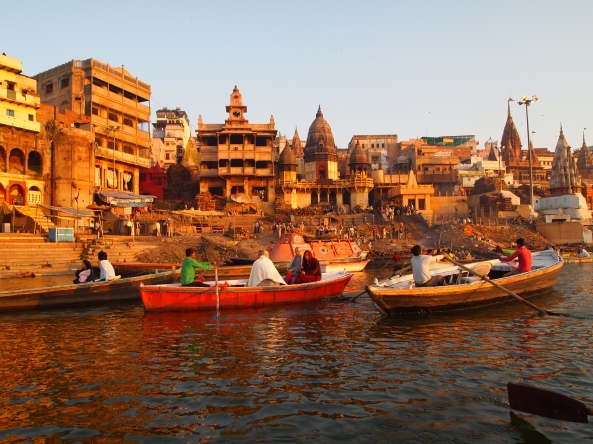
heading to the cremation ghat
Ajay, who is quite the charmer, tells us he’d like to take us to his place of business, where, surprise (!) he sells silk goods. Walking down the narrow alleys, we encounter a queue of cows bullying their way through; we have to push ourselves up against the wall to avoid getting underfoot or gored. Down another alley, cows are sleeping or just lounging on steps. Goats wander along and a dirty puppy jumps up performing tricks for treats, of which we have none to give him. We pass by vendors selling bags of sandalwood and spices and beautiful textiles. Flies swarm everywhere around the piles of cow shit on the streets. I feel like dirt and filth are jumping off the alleyways and buildings and animals and clinging to my clothes and skin.

cows napping on steps

Inside a Hindu temple
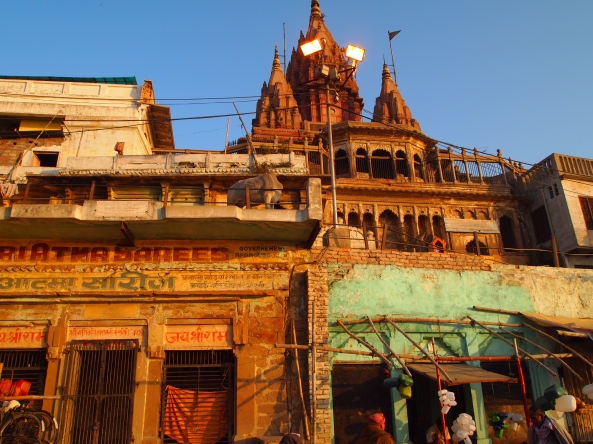
the streets near the burning ghats
We enter through a large courtyard surrounded by blue chipped concrete buildings hung with laundry, and into a room where we sit on carpets and lean against the wall. A fat Indian man offers me chai, while Ajay takes Jayne to the Golden Temple, or Kashi Vishwanath Temple. The current temple was built in 1776; 800 kg of gold plating were added to the tower and dome 50 years later. The temple has very strict security because the Gyanvapi Mosque is adjacent to it and there are obvious communal tensions; since we’re not allowed to take our bags, cameras or mobile phones in, we opt to go one at a time. I watch Jayne’s bag while she goes, and I sit and have a strained conversation with this fat Indian who, despite his attempts to be friendly, comes across as genuinely fake. When Jayne returns, I go down the street with Ajay, but I’m not allowed to even go inside the temple because I’m not Hindu! This is apparently one of the most famous temples in India dedicated to Lord Shiva. A Hindu is expected to do a pilgrimage here at least once in his lifetime. It’s a very cool street, and what I can see of the temple from outside the gate glows with gold, but, alas, I’m relegated to outsider status.

huge stacks of wood at the burning ghat

shaving in preparation for the burning of the corpse
Back at the silk shop, the fat Indian has started taking out silk scarves by the dozens. They are beautiful, but he tells us the price is 1,800 rupees (~$41). No matter how much we tell them they are too expensive, he continues to unfold them in waves of color before us. This is one place we later regret not taking pictures. This goes on for quite a long time, with piles of silken color before us. Finally we talk him down to 1,300 rupees (~$30), thinking foolishly that we’ve talked him down so we’ve got a bargain. I buy two and then on the way out purchase another for 1,000 (~$23). It’s funny sometimes how you get caught up in a moment, and you do stupid, VERY stupid things. This was way too much to pay for these scarves! We don’t even really know if they’re true silk or some kind of mimicry of the real thing!! First big rip-off in India!

an Indian woman selling flower blossoms

the courtyard outside of Ajay’s silk business

on the streets in Varanasi
Ajay asks if we’d like to meet the “famous” guru and we are curious about him so we go to Guruji Ashram. This guru, after showing us photographs of some blond girl who only vaguely looks like Goldie Hawn, tells us he can do several different tiers of fortune-telling, the cheapest being 1,100 rupees (~$25). One level goes up to 3,500 rupees (~$80)! He asks for our date, time and place of birth and then tells us to come back at 2:00.
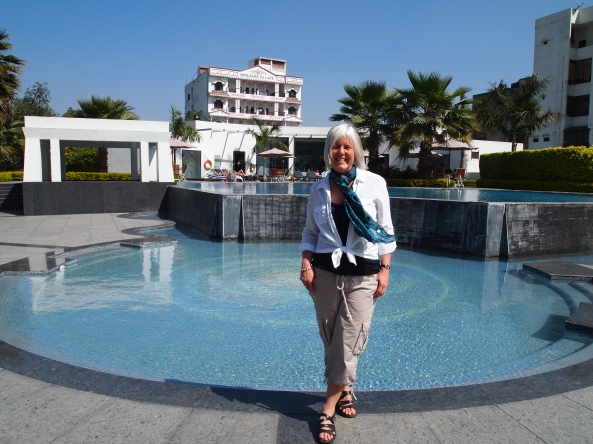
poolside at the Ramada after our showers… the only oasis in Varanasi
By this time it is only 9 a.m. and we head back to the hotel to shower and prepare for the day. Our driver Sanjay tells us that his duty with us is done and another driver will take us around Varanasi for the day. He doesn’t like us, it is clear, because we don’t just do everything he says. I think he is upset when we tell him we bought silk scarves from Ajay’s guy, yet we refused to see Sanjay’s Muslim guy for silk. He’s so pouty!! So, we’re actually happy we will have a new driver for the afternoon.

the lobby of the luxurious Ramada
Back at the hotel, Fahad, the bartender from last night, has saved a table for us in the breakfast room. He says, Where have you been? I’ve been looking for you all morning. We tell him we went on the sunrise boat ride on the Ganges. He is still being flirtatious and Jayne even notes that he seems to like me. It’s strange of course because he’s a lot younger than I am. He asks us what we plan for the day and even offers to take us to the monkey temple, which he says is his favorite place. We say we have our driver and have an entire sightseeing trip planned. He says he’ll be at the Toxic Bar tonight, so to come and say hi to him there. We wander around the hotel pool and wait for our new driver to pick us up for sightseeing.
Funny thing is, our new driver is… Sanjay. 😦 Obviously, he can’t get rid of us, and sadly, we can’t get rid of him. We seem to be stuck with him for the duration of our stay in Varanasi. We head out to the Bharat Mata Temple, also known as the Mother India Temple, which has on its floor a huge relief map of India and the Tibetan plateau, carved out of marble in three dimensions. The map is said to be perfectly to scale both vertically and horizontally with mountains, rivers, plains and oceans and the holy pilgrimage centers all clearly visible.
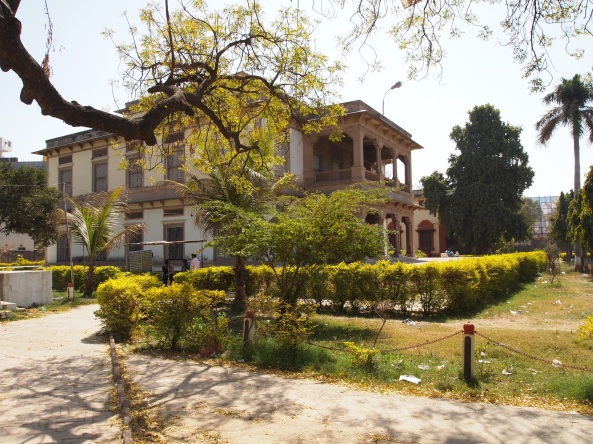
outside the Mother India Temple

the relief map of the indian subcontinent in the Mother India Temple
We then go to the small Durga Temple, better known as the “monkey temple.” We must leave our cameras behind, but it’s fine because we’re certainly not impressed. There are monkeys everywhere, and of course their droppings, so the place is filthy and smells disgusting. I find it one of the grossest places in Varanasi.
Sanjay then takes us on a drive through the campus of Benares Hindu University, established in 1916. I think as I drive through this campus that it would be difficult to teach in India because of the dilapidated state of the buildings and grounds.

Benares Hindu University

Benares Hindu University
On the grounds of the university is the New Vishwanath Temple, which unlike most temples in Varanasi is open to people of all religions. However, we happen to arrive there right at noon, when it is closed for an hour.
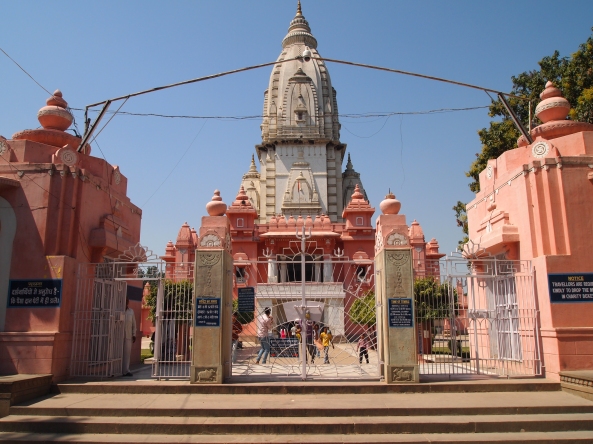
entrance to the new Vishwanath Temple

a market of flowers

colorfully-dressed women have a picnic
Finally, in the last of our temple tour, we stop at a beautiful red-painted temple where I buy a beautiful necklace of red flowers. However, they tell us we must leave our shoes and pay for them to “mind our shoes.” We say we don’t need anyone to “mind our shoes,” that we will just carry them in. Because of our insistence, suddenly we’re told we’re not allowed in after all, because we’re not Hindu. I can’t for the life of me remember the name of this temple.

flowers for sale to offer to the gods

the mysterious red-painted temple where we’re not allowed in because we’re not Hindu
Finally, at long last, we head back into Varanasi proper to see our guru. Sanjay drives through the chaotic streets, adding to the cacophony of horns by flexing his wrist constantly against the horn whether its necessary or not. We park at an old movie theater where we sit in the car waiting for Ajay to meet us and take us to see the guru. While we sit there, an Indian wearing a yellow silk turban comes up to our window with a snake in a basket. He wants us to give him 5 rupees for the privilege of touching his snake! I say, No, thanks! You’d have to pay ME to touch that snake!! Of course he won’t take no for an answer, but continues to harass us until we finally roll up the windows and ignore him.

inside the guru’s place
Back at the guru’s ashram, we are supposed to get a half-hour each with him, but we each end up with a 10-minute session. I climb some steep narrow stairs into a warm windowless room, where he invites me to sit on the floor and he tells me the following: I am a Scorpio and the Chinese sign of the sheep. I will live until 87 or 88 minimum, at which time I will die a natural and easy death in my sleep. I basically will have a good life with no problems. I’ll have my own property by the time I retire. I’ll have good health, although I might have some problems with gastric pain. He asks me if I currently have these kinds of problems, and I say no, I don’t. He tells me I’ve had four pregnancies. I protest and say I’ve only had 3, but he insists I must have lost one! He says I’m independent and don’t rely on anyone and I’m very strong and controlling in my family. He also says I have a mind like a child. He doesn’t mention anything about love, so I ask and he says I will have problems between life and love; I will have a man, but no fixed man. Men will come into my life and go. I ask if there’s anything I can do about that, and he says I can buy a talisman from him for 2,300 rupees (~$52). Ha!

our guru who allegedly worked with Goldie Hawn
After Jayne has her session with the guru, we have Sanjay drop us at the real Brown Bread Bakery, where we sit on cushions at low tables and order Kingfisher beers and several kinds of cheeses and breads and compare our guru sessions. Jayne tells me she can see where I might have a mind like a child because maybe I’m a little spoiled and gullible and I trust too easily. I find truth to her words so don’t feel too bothered by them. It’s a nice atmosphere inside, with music playing and a kind of hippie vibe to it.
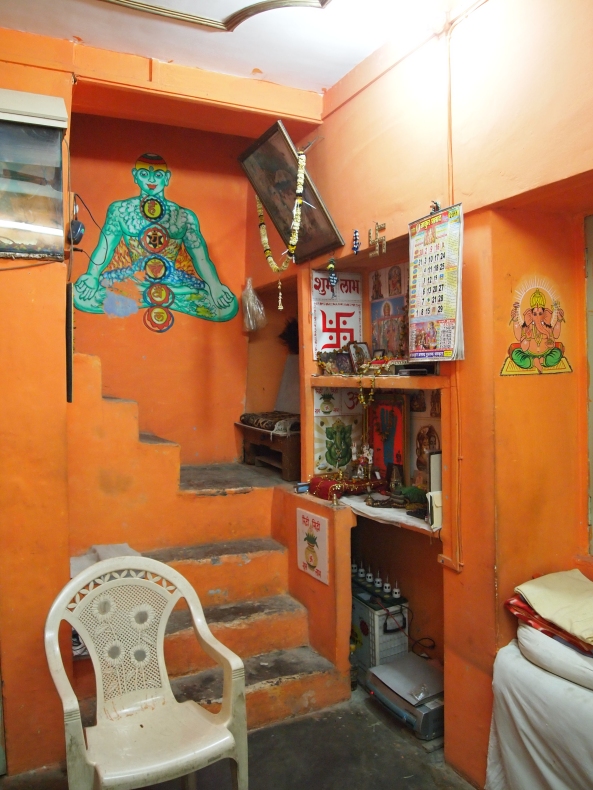
the guru’s ashram
After lunch, we wander around the ghats for several hours, just looking around until we go at 6 p.m. to grab a seat to watch a ganga aarti ceremony along the Dasaswamedh Ghat.

flowers for the gods
While we wait we see a wedding ceremony, with the groom dressed in his silken finest and his bride in sari demurely following behind him. A drunken man on the streets dances crazily to the wedding music, an interloper to this magical event. The ganga aarti ceremony is supposed to have puja, fire and dance, but after waiting for what seems like an eternity for it to start, we finally give up and head back to meet Sanjay at the movie theater. It turns out we get lost after walking probably a mile in the wrong direction; we eventually take a cycle rickshaw back to the movie theater, which was nowhere near the place we ended up on our walk.

huge crowds turn out for the ganga aarti ceremony

a wedding in progress
Back at the hotel I go into the Toxic Bar and order a red wine and a huge bowl of peanuts. Fahad is there and asks if I went to the monkey temple and I tell him yes, but we didn’t like it because it was so dirty. He says, Yeah, but it has all those monkeys running around! I say, yes, that’s just the problem. He tells me he lives in the city proper and walks 25 minutes to and from work every day. Then he asks me my age and I say, how old do you think I am? He says, I think maybe around 65-70!! I say, what? Wow! That is really an insult. Most people tell me I look in my 40s. This is the thing that infuriates me about Asians. Nearly every Asian I meet thinks I am much older than my age because of my white hair. They don’t even notice that I hardly have any wrinkles on my face (at least not yet!), or that I’m in fairly good physical shape.

a drunken dancer joins the wedding party
After this insult, I shut down and don’t even want to talk to him any more. But he keeps going on about how Spanish and Italian girls are so beautiful but not smart because they can’t speak English. I say the ability to speak English isn’t really an indicator of a person’s intelligence. He then goes on to complain about Thais, Koreans and Japanese, saying they always bring their own food with them to the hotel restaurant and they can’t speak English. I agree with him on this, because I know Koreans at least do take their own food with them when they travel and that most have trouble speaking English. I am bored by now and finish my wine and prepare to leave. He says, Enjoy your vacation, mam. I HATE that.. the “mam” thing. I really wish people would get over acting like I’m an elderly woman!! I’m still very young at heart. 🙂

waiting and waiting for the ganga aarti ceremony
All night I can’t sleep because I’m upset about the guru’s prediction of erratic love in my life, Fahad’s insult, and I am missing my friend Tao. It’s a long and fitful night despite being utterly exhausted from the frenzy of Varanasi. I am ready to move on from this place tomorrow. Little do I know that the next two days will be pure hell.


